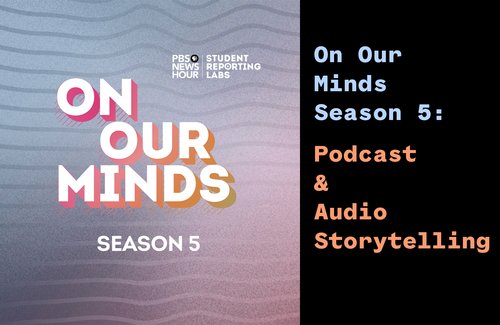
Student Reporting Labs’ award-winning podcast, On Our Minds, explores the teenage experience – made by teens for teens!
Season 5 will explore the theme: “Who Inspires You?” Student reporters will create audio stories and interviews that highlight who inspires them. Some ideas include: writers, friends, family members, teachers, neighbors, social justice activists, and pets.
Opportunities for students:
Students can produce an audio story about someone who inspires them during the fall or spring semesters. Episodes will be released in May 2025.
Listen to a few episodes of On Our Minds with a friend or classmate. Discuss what you heard:
Try to tell the STORY (not just opinions) of the person featured. The best stories are ones that bring to life: a person and their emotions, scenes and actions, challenges and conflicts. Stories show some kind of CHALLENGE and CHANGE: something happens and a person is changed. And what makes the story interesting? Specific details.
A group of people who live in the same area (such as a city, town, or neighborhood). It can also be a group of people who have the same interests, religion, race, etc.
People are interested in other people. Everyone has something to celebrate and something to complain about. We like unusual stories of people who accomplish amazing feats or handle a life crisis because we can identify with them.
In news, it’s a story’s point or theme. It's the lens through which the producer or writer filters the information they have gathered and focuses it to make it meaningful to viewers or readers.
A digital audio or video file or recording, usually part of a themed series.
An audio story within a podcast episode
A recording of something going on (versus an interview).
Note: Think b-roll but for audio.
A description of what your story might be and WHY it’s important. An outline of your story idea and the steps to achieve your goal. A summary of what you hope to accomplish in your story
A document with transcribed (written-out) soundbites and voiceover narration. A VIDEO script is a two-column document with the audio (soundbites and voice over) in the right-hand column and a description of what the audience sees (visuals) in the left-hand column.
A word-for-word document of what was said in a conversation or interview
An example of using a little person to tell a big story. For example, you want to tell a story about pollution in your community’s water system. That is a big issue. Your video will use the story of a person (character) to illustrate the effects of bad water quality.
An attempt to grab the reader or viewer’s attention with interesting information that will keep them reading or watching.
Students leverage technology to take an active role in choosing, achieving and demonstrating competency in their learning goals, informed by the learning sciences. (ISTE)
Students communicate clearly and express themselves creatively for a variety of purposes using the platforms, tools, styles, formats and digital media appropriate to their goals. (ISTE)
Journalism
Representation
Podcasting
Identity
Active Prompts
Beginner
Intermediate
Computers
Mobile Phone
Internet
4-6 Weeks